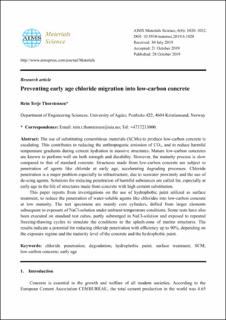| dc.contributor.author | Thorstensen, Rein Terje | |
| dc.date.accessioned | 2020-03-23T10:01:10Z | |
| dc.date.available | 2020-03-23T10:01:10Z | |
| dc.date.created | 2019-10-29T10:25:03Z | |
| dc.date.issued | 2019 | |
| dc.identifier.citation | Thorstensen, R. T. (2019). Preventing early age chloride migration into low-carbon concrete. AIMS Materials Science, 6(6), 1020-1032. doi: | en_US |
| dc.identifier.issn | 2372-0484 | |
| dc.identifier.uri | https://hdl.handle.net/11250/2648041 | |
| dc.description.abstract | The use of substituting cementitious materials (SCMs) to produce low-carbon concrete is escalating. This contributes to reducing the anthropogenic emission of CO2, and to reduce harmful temperature gradients during cement hydration in massive structures. Mature low-carbon concretes are known to perform well on both strength and durability. However, the maturity process is slow compared to that of standard concrete. Structures made from low-carbon concrete are subject to penetration of agents like chloride at early age, accelerating degrading processes. Chloride penetration is a major problem especially to infrastructure, due to seawater proximity and the use of de-icing agents. Solutions for reducing penetration of harmful substances are called for, especially at early age in the life of structures made from concrete with high cement substitution. This paper reports from investigations on the use of hydrophobic paint utilized as surface treatment, to reduce the penetration of water-soluble agents like chlorides into low-carbon concrete at low maturity. The test specimens are mainly core cylinders, drilled from larger elements subsequent to exposure of NaCl-solution under ambient temperature conditions. Some tests have also been executed on standard test cubes, partly submerged in NaCl-solution and exposed to repeated freezing-thawing cycles to simulate the conditions in the splash-zone of marine structures. The results indicate a potential for reducing chloride penetration with efficiency up to 90%, depending on the exposure regime and the maturity level of the concrete and the hydrophobic paint. | en_US |
| dc.language.iso | eng | en_US |
| dc.publisher | AIMS | en_US |
| dc.rights | Navngivelse 4.0 Internasjonal | * |
| dc.rights.uri | http://creativecommons.org/licenses/by/4.0/deed.no | * |
| dc.title | Preventing early age chloride migration into low-carbon concrete | en_US |
| dc.type | Journal article | en_US |
| dc.type | Peer reviewed | en_US |
| dc.description.version | publishedVersion | en_US |
| dc.rights.holder | © 2019 the Author(s) | en_US |
| dc.subject.nsi | VDP::Technology: 500::Materials science and engineering: 520 | en_US |
| dc.source.pagenumber | 1020-1032 | en_US |
| dc.source.volume | 6 | en_US |
| dc.source.journal | AIMS Materials Science | en_US |
| dc.source.issue | 6 | en_US |
| dc.identifier.doi | 10.3934/matersci.2019.6.1020 | |
| dc.identifier.cristin | 1741562 | |
| cristin.qualitycode | 1 | |

